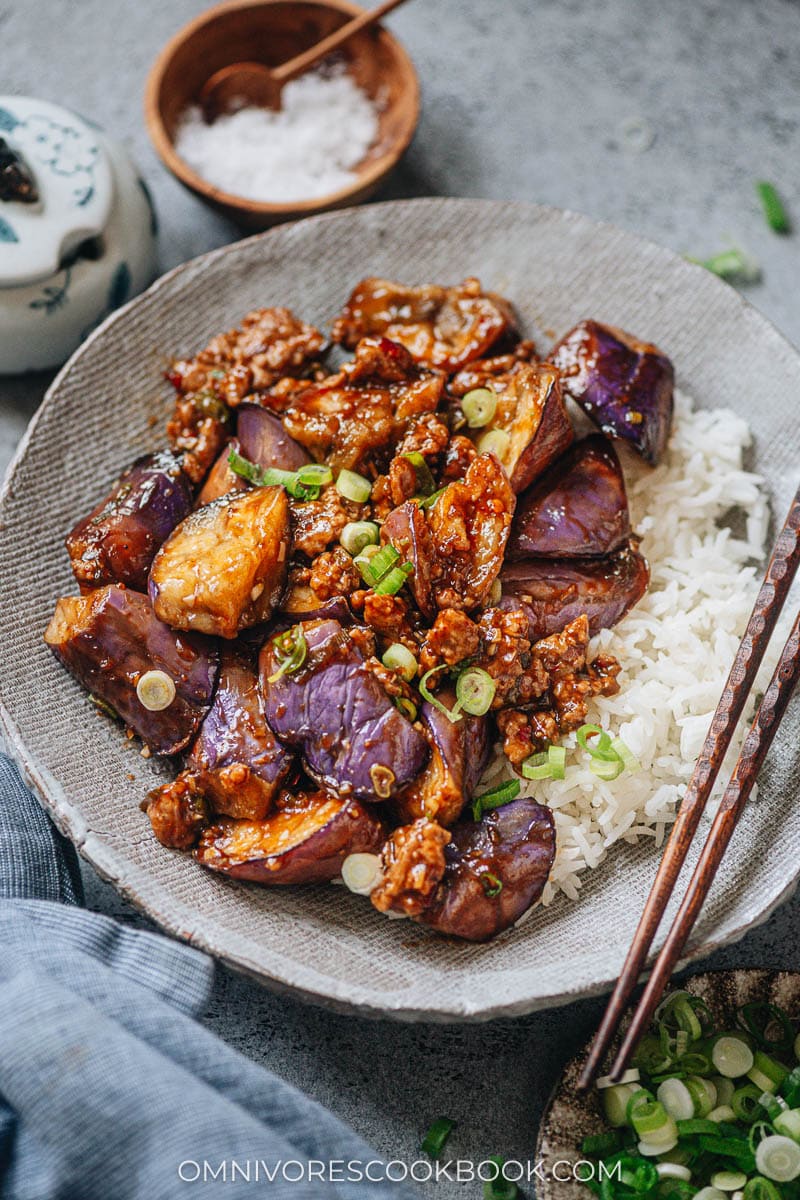
Yu Xiang eggplant (鱼香茄子), or Sichuan eggplant stir fry, is one of those under-appreciated Sichuan dishes that deserves more attention. Throughout the years, whenever I took a foreign friend or colleague to a Sichuan restaurant in Beijing, this dish was always one of the most popular Chinese vegetable stir fry recipes on the table.
What is yu xiang?
Yu xiang literally translates as “fish-fragrant” in Chinese, which might not sound as appetizing as the dish tastes.
In fact, fish-fragrant eggplant has nothing to do with fish.
According to folklore, a housewife was cooking eggplant for dinner and did not want to waste the leftover sauce used in a fish dish. The sauce was designed to cover up the fishiness and muddiness of river fish, so it was extra fragrant. The dish turned out so well and her husband loved it more than the original fish dish. Thus, the dish was named yú xiāng or “fish-fragrant” as an homage to the delicious sauce.
Yu xiang flavor is one of the seven key flavors in Sichuan cuisine. It contains soy sauce, Chinkiang vinegar, sugar, fermented spicy bean paste (dòubànjiàng), chili peppers, and a generous amount of fresh garlic, ginger and onion. It results in a well-balanced, sweet and sour spicy sauce that is bursting with umami. The taste might be considered similar to General Tso’s sauce, only 10 times more flavorful.
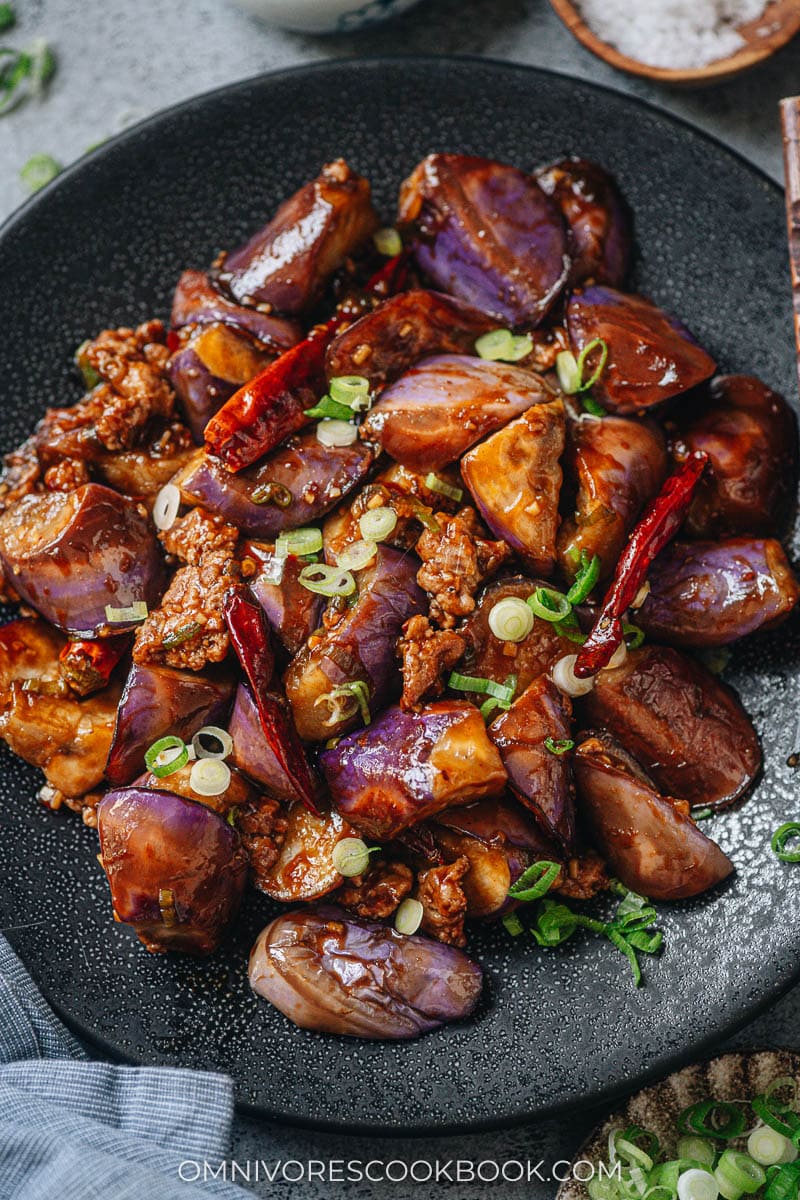
Yu xiang eggplant ingredients
What type of eggplant to use
The best eggplant for making yu xiang eggplant is Chinese eggplant or Japanese eggplant (they are very similar).
The long and skinny Asian eggplant contains less moisture than the Western type, which results in a crispier texture in the stir fry. However, you can also use Western eggplant by following the salt water soaking method in this recipe.
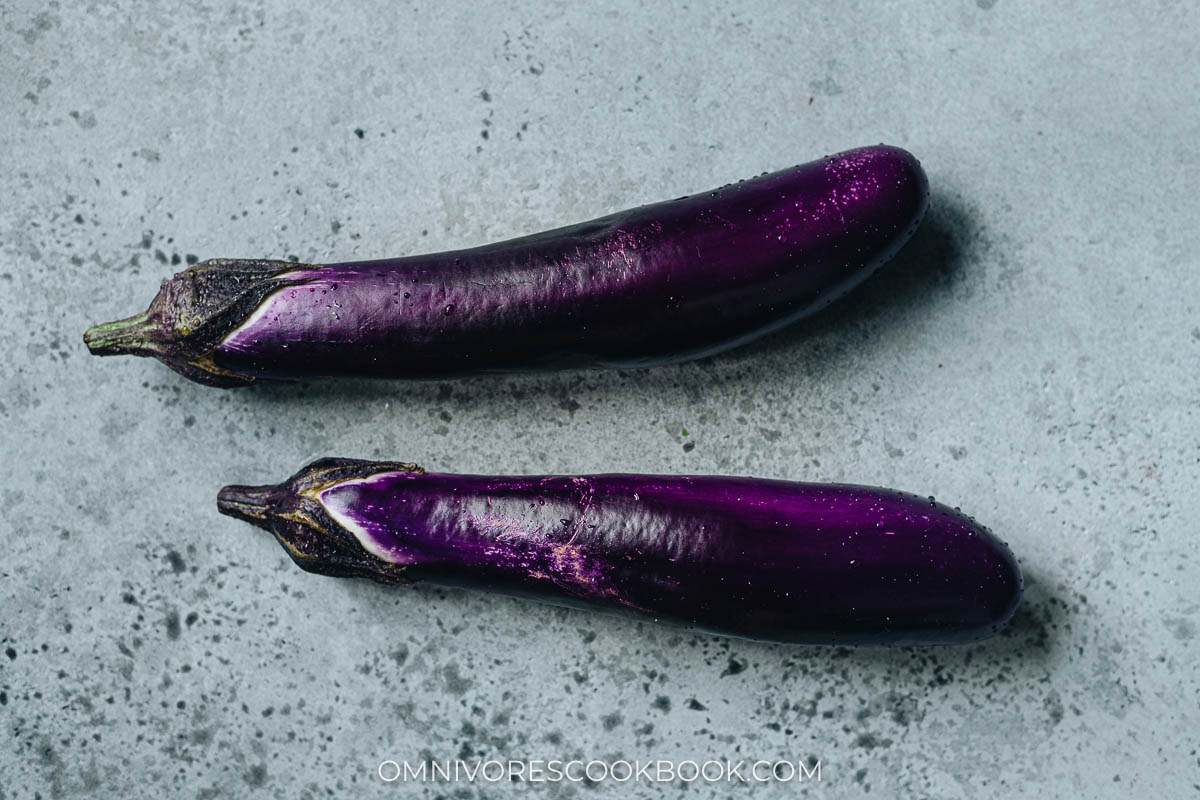
The best vinegar to use
Some yu xiang eggplant recipes call for rice vinegar. But if you really want the rich tangy taste like the restaurant version has, you should use Chinkiang vinegar instead.
Chinkiang vinegar (Zhenjiang vinegar, 镇江香醋) is a type of Chinese black vinegar. It is made from various grains and is aged until the color turns dark brown or inky black. It has a rich, pungent, and tart flavor, sometimes with a hint of sweetness. It has a fermented malty taste and a woody character that distinguish it from the light-colored and fruity rice vinegar.
These days it’s quite easy to find it in an Asian market and even at regular grocery stores. You can also shop for it on Amazon.
Doubanjiang
Doubanjiang (豆瓣酱), also called fermented spicy bean paste, is a key ingredient for the ultimate umami. It is a super rich, fermented, spicy paste made with dried fava beans, fresh chili peppers, salt, and wheat flour, then aged for one to eight years. Doubanjiang has a deep savory, spicy, and quite salty taste. It is a key ingredient in classic Sichuan dishes such as Mapo Tofu.
You can find it in an Asian market, on Amazon, or at Mala Market.
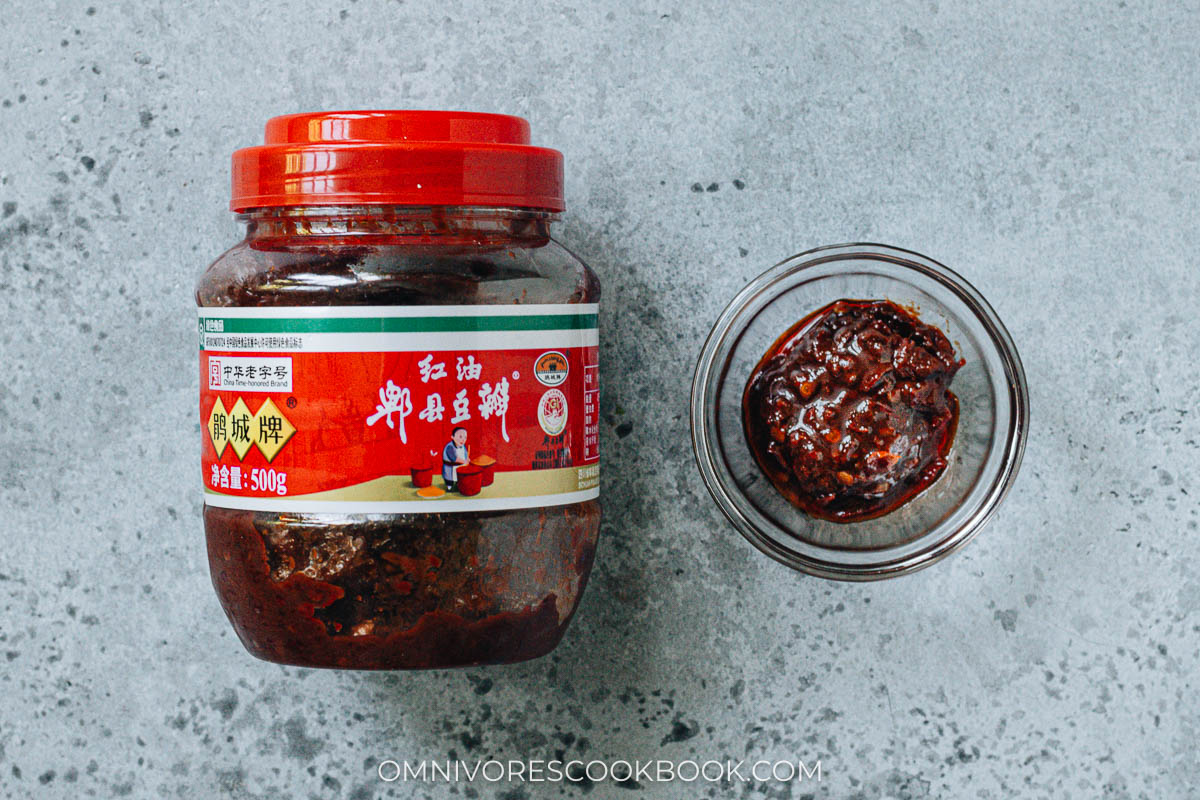
Sichuan peppercorns
Sichuan peppercorn (Hua Jiao, 花椒) is optional but I highly recommend adding it if you have it on hand. The taste of fresh Sichuan peppercorn is almost indescribable: numbing, tingling, and somewhat refreshing like mint. These peppercorns add a savory, smoky, and slightly citrusy flavor to a dish, and it’s that flavor that defines genuine Sichuan food. I consider it even more important than Sichuan chili peppers, truly distinguishing the dish and giving it a character unlike anything else. It’s a key ingredient in many classic Sichuan dishes such as Dan Dan Noodles, Mala Chicken, and Red Oil Wontons.
I highly recommend you purchase Sichuan peppercorns from Mala Market. They carry the freshest Sichuan peppercorns in the US, sourced directly from Sichuan. It truly makes a world of difference.
Mise en place
When you’re ready to cook yu xiang eggplant, your table should have:
- Mixed sauce
- Ground meat
- Aromatics (ginger, garlic, green onion)
- Sichuan spices (Doubanjiang, Sichuan peppercorns, dried chili pepper)
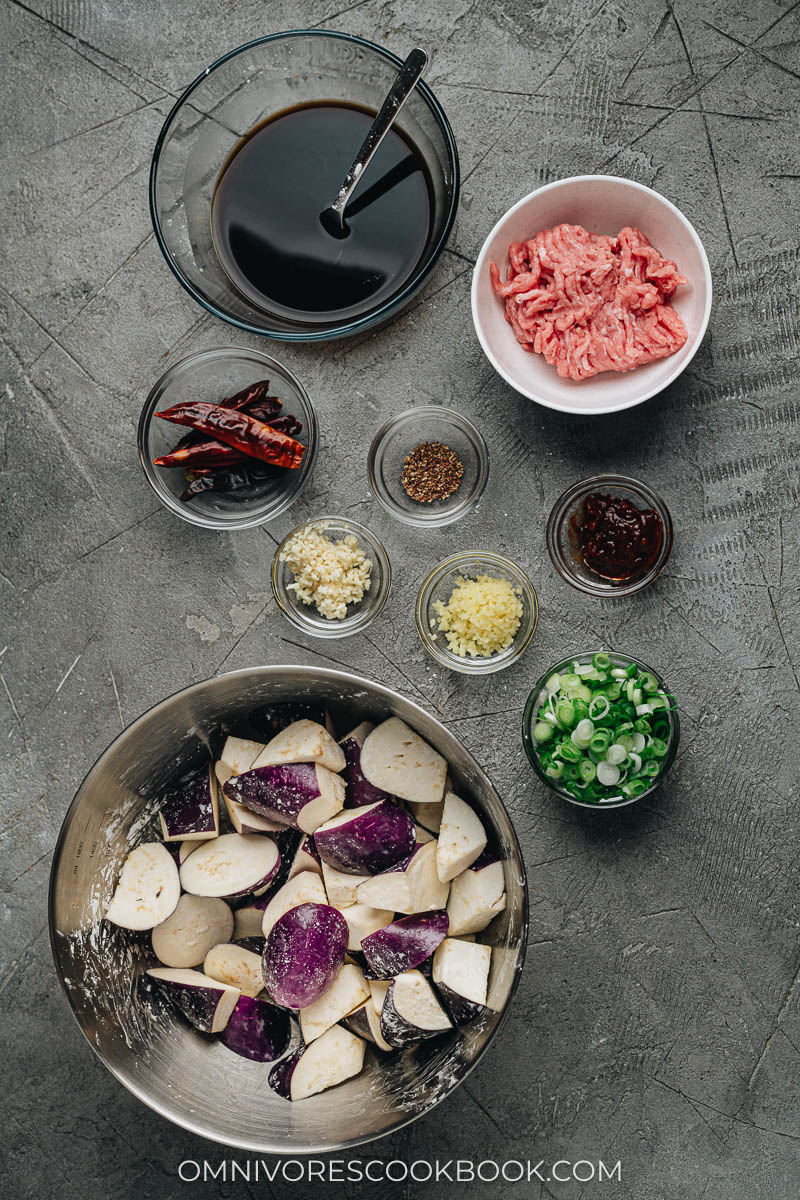
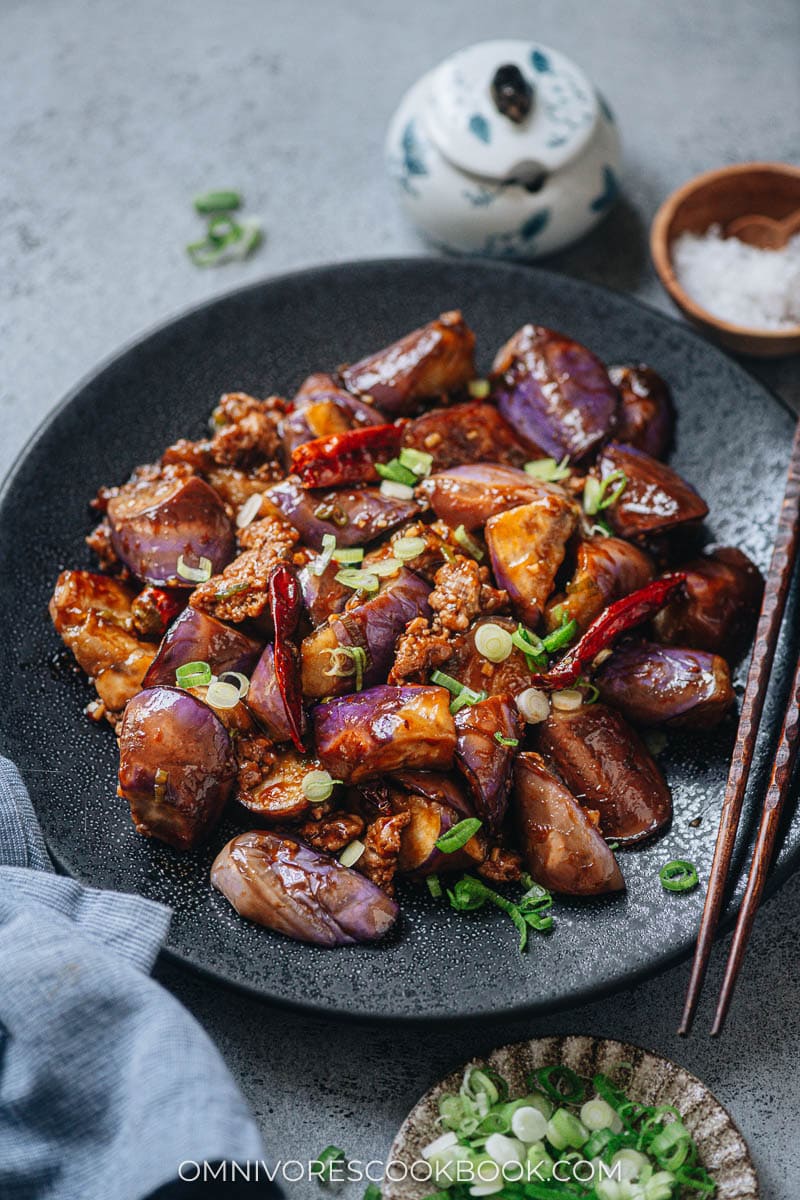
How to make yu xiang eggplant
- Pan fry the eggplant until crispy
- Sear the ground meat
- Add the aromatics
- Cook with doubanjiang and Sichuan peppercorn
- Thicken the sauce
- Add the cooked eggplant back in
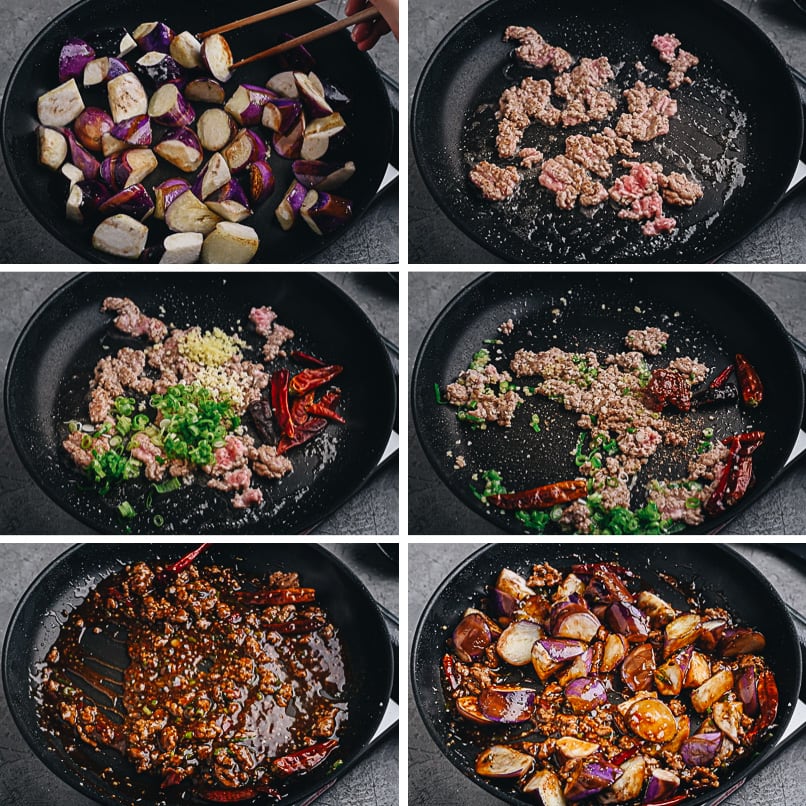
The secret to cooking perfect eggplant on the stovetop
Eggplant is one of the trickiest vegetables to cook with, though the result is super rewarding if you do it right. In the past, I’ve discovered the method of creating crispy eggplant on the stovetop without deep-frying. The key is to marinate the eggplant in salted water and then dust it with cornstarch before searing it on a flat-bottom pan. You can read my Chinese Eggplant with Garlic Sauce recipe to view the details.
With this technique the eggplant pieces turn out extra crispy with a tender inside. Better still, you can use regular Western eggplant instead of Asian eggplant, and it will work perfectly!
It proves again that you can cook perfect yu xiang eggplant if you follow the right method. Next time you don’t need to make the extra trip to the Asian market to make this hearty dish.
How to keep the purple color of the eggplant?
The yu xiang eggplant from a Chinese restaurant has a beautiful bright purple color. It is achieved by flash frying (过油, Guo You) – the eggplant pieces are quickly fried in a pool of oil in a wok, until the outside is crispy and the inside is al dente. Many dishes use this method to preserve the color of the vegetable while maintaining a great texture.
I do not use the flash frying method at home because it requires a lot of oil. It is quite messy for a home kitchen, and creates a lot of smoke.
The pan frying method cuts the oil to a minimum, and the result is still great. To preserve the eggplant color, try cooking the eggplant until al dente instead of turning tender fully, for the best color.
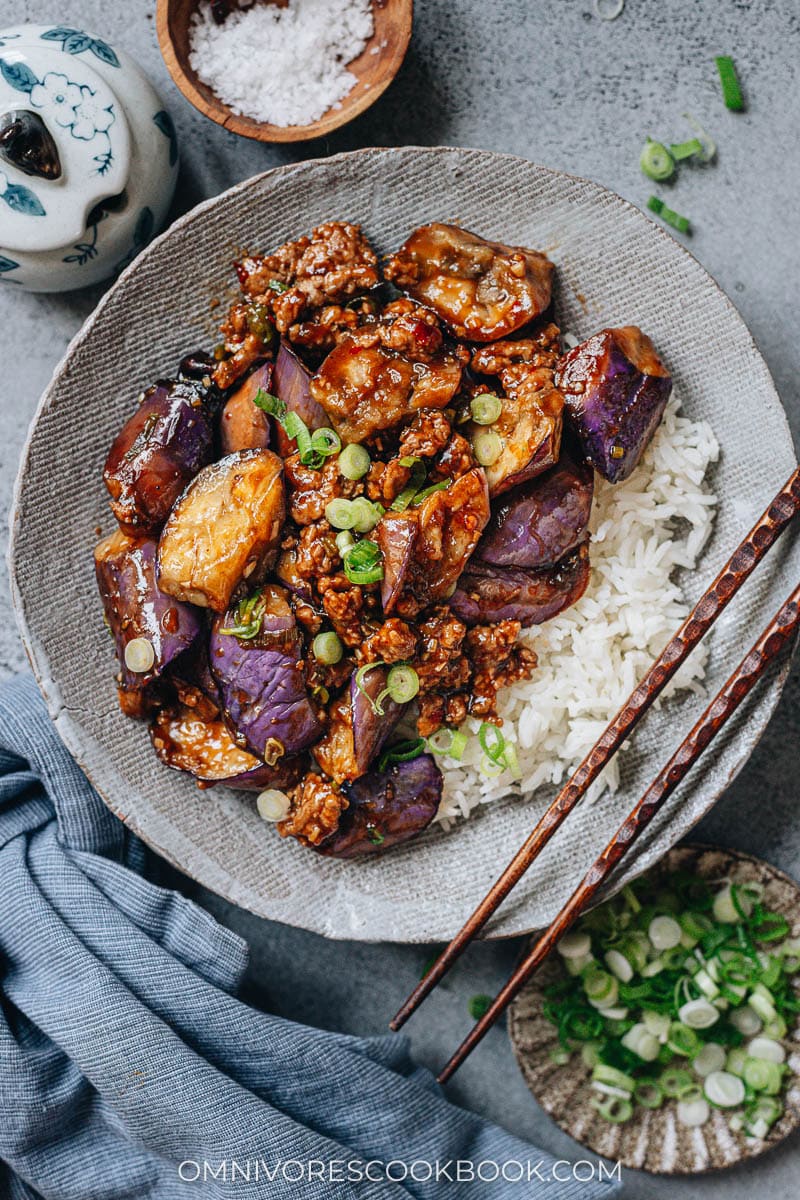
How to serve yu xiang eggplant
Yu xiang eggplant is a very satisfying dish that you can serve as a main dish over steamed rice. In China, this one is a lunch set menu favorite!
Of course you can also serve yu xiang eggplant as part of a multi-course meal. For a full-on Sichuan dinner, serve this one along with dishes such as Pickled Cabbage, Mala Chicken (La Zi Ji), Dry Fried Green Beans, Dan Dan Noodles, and Stir Fried Pea Shoots.
More vegetable main dishes
- Chinese Eggplant with Garlic Sauce
- Di San Xian (Fried Potato, Eggplant and Pepper in Garlic Sauce 地三鲜)
- General Tso Tofu (Crispy Tofu without Deep Frying)
- Chinese Vegetarian Noodle Soup
- Vegetarian Chow Mein
Chinese Cooking Made Easy
Are you new to this website? This free email series is a great place to start. I’ll walk you through a few of my most popular recipes and show you how and why they work. You’ll quickly start to cook better Chinese food in your own kitchen.
Watch video

Yu Xiang Eggplant (鱼香茄子, Sichuan Eggplant Stir Fry)
Ingredients
- 2 Chinese eggplant , cut to bite-sized pieces (or regular eggplant) (*Footnote 1)
- 1 teaspoon salt
- 2 teaspoons cornstarch (to coat the eggplant)
Sauce
- 2 tablespoons Chinkiang vinegar
- 1 1/2 tablespoons light soy sauce (or soy sauce)
- 1 tablespoon Shaoxing wine (or dry sherry)
- 2 tablespoons sugar
- 1/4 cup chicken stock (or vegetable stock)
- 2 teaspoons cornstarch
Cook
- 3 tablespoons peanut oil (or vegetable oil)
- 4 oz ground pork (or chicken) (*Footnote 2) (Optional)
- 2 green onions , sliced
- 2 cloves garlic , minced
- 1 tablespoon ginger , minced
- 8 to 10 dried Chinese chili peppers
- 2 teaspoons doubanjiang
- 1/4 teaspoon ground Sichuan peppercorn (Optional)
Instructions
- Place eggplant in a large bowl and add water to cover. Add 1 teaspoon salt, mix well. Place a plate on top so the eggplant pieces are submerged in the water. Let sit for 10 to 15 minutes while preparing the other ingredients. Once done, drain and pat dry with paper towels.
- Add all the sauce ingredients into a bowl. Stir to mix well.
- Sprinkle eggplant with cornstarch and mix by hand, until eggplant is evenly coated.
- Add 2 tablespoons of the oil to a large skillet and heat over medium-high heat until hot. Spread eggplant across the bottom of the skillet without overlapping. Cook the eggplant, stirring occasionally, until the edge of the eggplant is lightly charred and the texture just starts to soften, 5 minutes or so. Transfer to a plate. If the skillet gets too hot and starts to smoke, turn to medium heat.
- Add the remaining 1 tablespoon of oil and the ground meat. Cook and chop the pork into smaller pieces, until fully cooked.
- Add green onion, garlic, ginger and chili pepper. Stir a few times to release fragrance.
- Add the doubanjiang and Sichuan peppercorns. Stir and cook until the pork is evenly coated.
- Stir the sauce again to completely dissolve the cornstarch, then pour into the pan. Stir until the sauce thickens. Return the eggplant to the pan and quickly stir to mix everything well. Serve hot as a main dish or side dish.
Notes
- Long Asian eggplant (Chinese or Japanese eggplant) works the best and the soaking step can be skipped if you are using one of those two kinds. You can use regular Western eggplant instead. But make sure you use the salt soaking method if using regular eggplant.
- You can skip the ground meat to make a vegan dish and the sauce will still be very tasty.
Nutrition

Did you make this recipe?
I’d love to hear how it turned out for you! Please take a moment to leave a 5-star rating ⭐️ and share your thoughts in the comments further down the page. It really helps others discover the recipe too.

Emmie
YUM! I could’ve used low sodium soy sauce, but it’s super delicious and I appreciate how you don’t skimp the the sauce. So many similar recipes don’t make nearly enough sauce. Also, thank you for instructing how to infuse the oil with the peppercorns….way more enjoyable than leaving them in. Will be using your site from now on!
Maggie
I’m so glad to hear you tried and like the recipe, Emmie! It’s one of my favorite eggplant dishes 🙂 Looking forward to hearing more dishes you will cook in your own kitchen!
Donna
I made this eggplant dish tonight. First of all, I love, love, love eggplant, especially Thai, Chinese, or Italian. The recipe posted here was absolutely delicious! The one thing I changed up was adding more peppers. We love the heat. Thank you for this recipe.
Jacqueline
I have been making this dish for years…ever since I first saw it on your website! It is one of my favorite dishes and has become a weekly regular. Thank you so much!
Maggie
Hi Jacqueline, thanks for much for leaving a comment and I’m glad to hear you like the dish as much as I do! Top it on hot rice, so irresistible!
Rob
Hi, I’ve been enjoying this recipe as one of my ‘go-to’ quick dinners for a while, but just recently noticed you have changed it (inclusion of stock, use of szechuan peppercorns etc). We found the new version was not as nice as the original . Can you you send me the original version?
Many thanks,
Rob
Maggie
Hi Rob, sorry for the slow reply! Here is the original version if you still need it:
1 large long eggplant (300 grams / 10 ounces), cut into strips
1 1/4 teaspoon salt
3 teaspoons cornstarch
2 teaspoons light soy sauce
1 tablespoon Chinkiang Vinegar (black rice vinegar)
1 teaspoon Shaoxing wine
1 teaspoon minced ginger
100 grams (3.5 ounces) ground pork
1 teaspoon Doubanjiang (chili bean paste)
2 fresh Thai chili peppers, chopped (or 1 pepper for less spicy dish)
1. Add eggplant and 1 teaspoon salt into a large pot of water and mix well. Place a lid on top of the eggplant to keep it submerged in the water. After 10 to 15 minutes, drain the eggplant and dry it thoroughly with a paper towel. Sprinkle 2 teaspoons cornstarch over the eggplant, 1 teaspoon at a time, and rub it by hand to coat all eggplant strips well.
2. Combine light soy sauce, vinegar, Shaoxing wine, 1/4 teaspoon salt, sugar and 1 teaspoon cornstarch in a small bowl, mix well, and set aside.
3. Heat 2 tablespoons of oil in a big nonstick skillet over medium high heat. When oil is hot, after about 2 minutes, carefully add eggplant and stir fry until the eggplant turns soft and golden brown on the outside (* see footnote 1), 5 to 6 minutes. Transfer eggplant to a plate and set aside.
4. In the same skillet, add 1 teaspoon oil, garlic and ginger, and give it a stir. Add ground pork and stir fry until surface of pork turns white, about 1 minute. Add Doubanjiang and continue stirring constantly until pork mixes with the paste and turns dark red, about 1 minute. Add Thai pepper and eggplant and give it a stir. Evenly pour the mixed fish fragrant sauce (from step 2) over the eggplant and stir immediately to mix everything well, for 1 – 2 minutes. (optional) Turn to lowest heat and taste the eggplant (be careful, the eggplant will be very hot!). Adjust flavor by sprinkling a bit more salt or sugar, then turn to medium heat and use a spatula to mix everything well again (*see footnote 2). Stop heat and transfer eggplant with the pork and sauce to a plate.
5. Serve warm with steamed white rice.
Jean
Salut Maggie,
Merci pour tes recettes aussi délicieuses les unes que les autres ! Non seulement tu régales nos papilles mais en plus tu enrichis notre culture culinaire à travers la genèse de chaque recette ! Bravo et continue de nous émerveiller ! ??
Jean Rabefaniraka
Salut Maggie,
Tes recettes sont formidables….non seulement tu nous régales mais en plus tu nous instruits à travers la genèse de la recette.Le choix est vaste et satisfait même les plus difficiles ! Tu côtoies l’excellence et tu enrichi notre culture culinaire…merci pour ton partage et continue de nous émerveiller ! ???
Amy
I LUUUUUV eggplant! This has to taste like a rock band in your mouth. Definitely will be trying this. Thank you.
Maggie
Yes definitely! Happy cooking Amy and let me know how the dish turns out 🙂 This is one of my favorites and I hope you enjoy it too!
Nick
This dish looks delicious! I’ll have to make it when eggplants come into season this summer.
But I’m really curious about the key flavors of Sichuan cuisine. What are the other six? I assume one is mala?
Maggie
Nick, yes one of the flavors is mala. The other six Sichuan flavors are:
Mala (Numbing spicy) – see my Mala chicken recipe: https://omnivorescookbook.com/mala-chicken/
Spicy – mapo tofu https://omnivorescookbook.com/recipes/authentic-mapo-tofu/
Tangerine – it has spicy, numbing and a citrus flavor
Numbing – Mostly sichuan pepeprcorns, mixed with other savory flavor
Weird (guai wei) – the sauce is nutty, spicy, numbing, sweet, savory, and sour. see https://omnivorescookbook.com/sichuan-chicken-with-spicy-sesame-sauce I know the name might sound strange…
Sour spicy – like the fish with pickled mustard dish https://omnivorescookbook.com/suan-cai-yu
You need to try out the eggplant! It’s one of my favorites and I believe you’ll like it too 🙂
Nick
Thank you! I love learning about the different cuisines of China through the delicious recipes on your blog!
Maggie
You’re the most welcome Nick! I’m so happy to hear you care about Chinese food 🙂
Happy Friday and have a great weekend!
J-Mom
I finally had a chance to stop-by the nearest Asian grocery store (that’s two hours away) and got Chinese eggplant to make this. The eggplant came out really nicely. My husband mentioned the crispiness without me pointing it out (although, he thought it was mushroom). Thank you for the recipe.
J-Mom
I forgot! I couldn’t get fresh Thai chili. I used dried ones and stir-fried it in oil hoping that the spiciness would transfer. Is there a good way to substitute with dry chili or red pepper flakes?
Maggie
I’m glad to hear you and your husband enjoy the dish!
To answer your question, yes, dried chili peppers and red pepper flakes definitely work. In fact it’s the more proper way to do it, in an authentic Sichuan way.
I happened to have Thai chili on hand that time so I ended up using it. To make the sauce spicy, you can either snip the dried chili peppers to 2 to 3 pieces (to reveal the seeds) or add about 1 teaspoon chili flakes (depends on the spiciness of your chili flakes).
Hope you have a delicious week ahead J-Mom 🙂
Alona Orina
i will give it a try tonight for I am planning to prepare healthy and yummy eggplant dish for my hubby. as eggplant is pone of our fave veggie, i am so bored with the same method i cook that is why I am searching different way of cooking eggplant and i came across to this. Thanks to this ms maggie, more power.
Maggie
Hi Alona, I’m glad to hear you decided to give this dish a try! I hope your cooking goes well and the dish turns out great 🙂
If you need another eggplant dish, try out this one too: https://omnivorescookbook.com/chinese-eggplant-with-garlic-sauce It’s one of the most popular recipes on my blog.
Let me know how the cooking goes!
jack wolfskin canada
Thanks so much for this! I have not been this moved by a blog post for quite some time! You have got it, whatever that means in blogging. Anyway, You are definitely someone that has something to say that people need to hear. Keep up the wonderful work. Keep on inspiring the people!
jack wolfskin canada http://www.jackwolfskinoutlet.store
Kit
So glad I found your website. Looks like my search is over! This is going to be my one-stop go to for Chinese recipes! I have been trying to find authentic chinese eggplant recipes and have tried so many not-so-good ones. I’m from Shanghai and I appreciate all food and I cook Italian and American on most days. But the fusion recipes on traditional dishes just don’t cut it for me. I tried this one tonight and love it! Thank you for sharing! Mapo Tofu is next.
Maggie
Hi Kit, I’m so glad to hear you tried my recipe and enjoyed the dish! Sorry to reply this so late. I’ve been traveling back to China this month and stayed offline most of the time. We cook a lot of Italian and American too (also Mexican!), but just like you said, I crave for the authentic Chinese dishes every now and then. I love Shanghai food, although some of them are very challenging to make. Soup dumpling is on my cooking list of 2016 🙂
Please let me know if you want to learn a new recipe but couldn’t find on my blog! I’d love to develop the recipe for you!
Happy cooking and Happy New Year!
Yelena
I’d love to see a recipe for soup dumplings!!
Michael
I don’t have the Chinkiang vinegar or the rice wine, can I just use malt vinegar and leave out the wine?
Maggie
Hi Michael, I believe you can use malt vinegar as an alternative. And yes, you can leave out the wine and replace it with water. The wine adds a nice subtle flavor, but it won’t be a problem without it. Happy cooking and hope the dish turns out great 🙂
Sue
If you don’t have Chinkiang vinegar, you can use Balsamic vinegar.
Samantha
This looks really good, I will try this next week. I’ve been steaming my eggplants before stir frying them. That really cuts down on the oil. I add salt and fish sauce while steaming the eggplants too.
Maggie
Hi Samantha, thanks for sharing the tips! I like fish sauce and it sounds lovely with the eggplant. I steam eggplant too, but only used it in cold dishes. I like the crispiness of eggplant in stir fried dishes, but it does use more oil. Ultimate dilemma!
Harvey
tried this recipe today and it was pretty darn close to restaurant quality (but without the oil!)
great technique. thanks for sharing!
Maggie
Hi Harvey, thanks very much for leaving a comment and I’m so glad to hear you tried my recipe! Hope you enjoyed the dish and have a great day ahead! 🙂
Arnab Sen (@arnab)
The fish fragrant sauce contains no fish at all!?
Maggie
Nope, no fish in this one.
“Fish fragrant” is a special combination of condiments that commonly used in Szechuan cuisine. It is said the sauce was originally used for cooking fish, but when people tried the sauce with other dishes, they found they are all very tasty, for example fish fragrant pork.
I think it’s similar to sweet sour sauce, goes well with everything. But this one has “fish” in the name, so sounds confusing.
Trent @ Food Assault
That looks fantastic……such vibrant colours. I, like many, didn’t like eggplant as a kid however love it now.
One of my favourites is vegetarian lasagne made with eggplant. I’ll need to give this a try Maggie, thanks for sharing.
Maggie
Hi Trent, thanks for stopping by and commenting!
Vegetarian lasagne sounds great. I just got a pasta machine from a friend, and I’d like to try it out with the freshly made pasta. 🙂
nicole (thespicetrain.com)
Wow, your entire blog looks fantastic and makes me so hungry! I”m gonna have to start making a whole bunch of your recipes!
Maggie
Hi Nicole, I’m so glad you like my blog! Cannot wait to hear your feedbacks for my recipes! 🙂
nicole (thespicetrain.com)
This recipe is a winner! I made it today and it was a universal success. What a great idea to soak the eggplant strips in water!
I substituted sake for Shaoxing wine and used sambal instead of Doubanjiang. Are these two ingredients reasonably close? Even if not, the dish tasted great! 🙂
Maggie
Hi Nicole, I’m so glad to hear that you make this dish and found it delicious! Sake is very similar with Shaoxing wine but I never thought I can use sambal in this one! It sounds great too and I’ll remember to try it out myself. 🙂
Nami | Just One Cookbook
I loved watching your video! Eggplant is my favorite veggies and this sounds really delicious. I always wish that they don’t absorb much oil while cooking. That’s one negative thing about this veggie, but I love that it absorb sauce… haha. Looks delicious!!!
Maggie
I totally agree with you about eggplant absorbs too much oil! They don’t taste so great if cooking with less oil and I already tried my best to reduce the oil to minimum amount.
I’m so glad you like my video. It really took time to shoot and do post edit, but it was a lot of fun! 🙂
Steve Salloom
Nami & Maggie,
My mother taught me this method to avoid eggplants from absorbing oils:
1. Spread the sliced eggplant on a towel.
2. Sprinkle Kosher salt on both surfaces of the sliced eggplant.
3. Allow to rest for 45-60 minutes.
4. Pat dry each surface.
5. Do not rinse eggplants.
This method will extract the moisture from the eggplants and will allow very little amount of oil to be absorbed. Most oil will be on the outside.
Maggie
Hi Steve, thanks for sharing your method and I will try out next time! I think it will work great on fried eggplant too. Hope you have a great week 🙂
Michael
Did it work?
AvocadoPesot
Beautiful photo! I learned how to make this dish during a cooking class in Dali China and loved it!
Maggie
Thank you for stopping by! I hope this recipe will turn out as good as the one you learnt in Dali China! 🙂